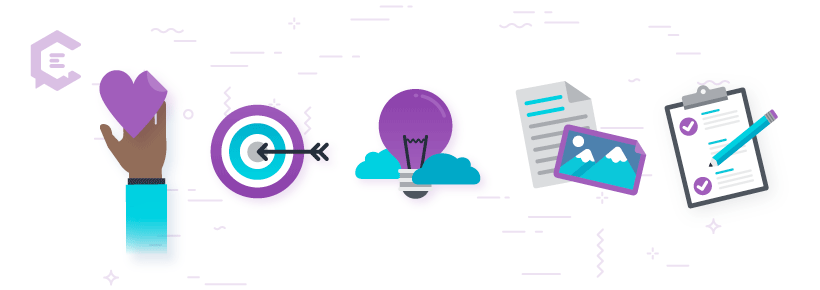The lines between content and visual design are blurring.
In a landscape where information is everywhere and attention spans are fleeting, it’s crucial to do everything you can to make your content stand out. It’s not enough to have high-quality written content. That content needs to be supported with a strong design strategy that captures and keeps your audience’s attention.
What’s the best way to do that? Integrating design thinking into your content creation. This article will deep dive into the world of design thinking and discuss how it can work together with your content marketing strategy to drive success.

What is Design Thinking?
While the ubiquity of the term “design thinking” seems to be enjoying a recent surge in popularity, according to author Jo Szczepanska, “Being in the news… doesn’t make design thinking anything new. Unlike the radical outcomes it promises, design thinking as an approach has been slowly evolving since the 1960s.”
Szczepanska’s Design Thinking Timeline takes readers on a fascinating journey of significant milestones in the movement, from Design Science in 50s-60s America, to the impact of Scandinavian cooperative design from the 60s-80s, to a third resurgence that happened between 1990-2005.
It was during this time that the design consultancy IDEO was formed and, according to Szczepanska’s research, gave the concept of design thinking a “foothold in the business world.”
From Szczepanska’s article: “Over the past fifty-plus years, design thinking… has appropriated many of the best tools and techniques from creative fields, social and computer sciences.”
Thinking by Design: A Definition
Although there are many definitions of design thinking, for the sake of this article, we’ll be concentrating on one:
“Design thinking is a non-linear, iterative process that teams use to understand users, challenge assumptions, redefine problems, and create innovative solutions to prototype and test. Involving five phases — Empathize, Define, Ideate, Prototype, and Test — it is most useful to tackle problems that are ill-defined or unknown.” – Interaction Design Foundation
As far as how it’s different from other processes, we’ll let Harvard Business School explain:
Design thinking is different from other innovation and ideation processes in that it’s solution-based and user-centric rather than problem-based. This means it focuses on the solution to a problem instead of the problem itself.
The Design-Thinking Framework
The Interaction Design Foundation summarizes the five phases of the design-thinking process (or framework) based on the Stanford d.school’s description of the process:
- Stage 1: Empathize — Research Your Users’ Needs
- Stage 2: Define —State Your Users’ Needs and Problems
- Stage 3: Ideate — Challenge Assumptions and Create Ideas
- Stage 4: Prototype — Start to Create Solutions
- Stage 5: Test — Try Your Solutions Out
As you consider these stages, the Interaction Design Foundation reminds us, “These stages are different modes which contribute to the entire design project, rather than sequential steps. Your goal throughout is to gain the deepest understanding of the users and what their ideal solution/product would be.”
A Word (or a few) About Design Strategy Research
Now that we’ve walked through a very brief history of design thinking — and we’ve bandied about the names of organizations like IDEO and Stanford’s d.school to help define and give context to the term — you may be wondering whether design research is the same as design thinking.
In two words: not exactly. But close.
A Designer’s Manual
In the first edition of their book, ‘A Designer’s Research Manual’, authors Jennifer and Ken Visocky O’Grady introduce “the concept of research-driven design… and what tools today’s designers are using to inform and ensure the success of their creative projects,” and “how research-driven design can help define an audience, support a concept, advocate for an aesthetic or measure the effectiveness of a campaign.”
As we shift our focus to content, let’s agree that design thinking is a framework — an approach to design — and that design research is a methodology (or collection of methods) that supports design thinking.
The Design Kit
To take it a step further, IDEO introduced the Design Kit, a set of tools to facilitate creative approaches to problem-solving using Human-Centered Design.
At the center of the toolkit is the ‘Field Guide to Human-Centered Design,’ described as a “step-by-step guide that will get you solving problems like a designer,” as well as the Design Kit travel pack, a deck of cards described as “bite-sized design tools to spark creativity and collaboration.”
Whether you call it design research or human-centered design, what these methodologies have in common is the placement of the consumer (user, customer, end-user) at the center of the design process.
A Design Strategy Framework Example
1. The Quad
Chances are, if you are a practicing content strategist, somewhere along the way in your career, you’ve come across ‘Content Strategy for the Web’ (2nd Edition) by Kristina Halvorson and Melissa Rach.
Halvorson’s book — and her definition of content strategy — has been credited with establishing the practice as essential to agencies and enterprises.
In the third chapter of the book is a simple but impactful illustration called “The Quad,” described as “…an image that displays the critical components of content strategy,” or how content strategy works.
Created over a decade ago, The Quad also addresses:
- Substance and structure: the content components needed to implement and support the core strategy
- Workflow and governance: the people components needed to implement and maintain the strategy
Of course, as the discipline of content strategy has evolved and expanded to include content design and related disciplines, so too has The Quad.
The new quadrants include Editorial, Experience, Structure, and Process. For our purposes — to show the intersection between design thinking and content strategy — we’ll focus on Editorial and Experience.
According to Halvorson:
Editorial strategy answers the following questions:
- What is our editorial mission?
- Who are our target audiences?
- What is our point of view?
- What is our voice and tone?
- What brand and language standards do we need to comply with?
Experience design answers the following questions (among many others):
- What are our users’ needs and preferences?
- What does our content ecosystem look like?
- What are our customers’ journeys?
- What formats will our content take?
- How will design patterns shape our content on mobile and beyond?
Editorial considerations draw parallels to the first two phases of design thinking:
- Empathize: the audience’s point of view
- Define: voice, tone, and language standards
The third phase, Ideate, sits nicely between editorial and experience design, where you take what you know about your mission, audience, voice, tone, and brand standards and use that knowledge to move into experience design, and the last two phases of design thinking:
- Prototype: content ecosystem and format
- Test: design pattern impact on mobile and beyond
Design Strategy Principles in Your Content Creation
While it’s great to know that there are parallels between design strategy and content creation, you may be wondering, “How do I get started?”
Design strategy and content creation both have the same purpose: to create a product that meets the needs of users in the most creative and consumable way. So if “agreeing to disagree” doesn’t cut it, then how do we make peace so we can make progress?
Perhaps an agreed-upon set of principles is a good place to start.
Establishing an agreed-upon set of principles from the start of a project can help foster a partnership. Starting with a common language — design thinking — can facilitate a collaborative process to avoid pitfalls as timelines progress.
There are principles of each discipline that overlap and others that are distinct. Here’s a guiding set of principles for user experience designers that should be a shared goal for both content and design:
- Understand the underlying problem before attempting to solve it
- Don’t hurt anyone
- Make things simple and intuitive
- Acknowledge that the user is not like you
- Have empathy
From there, each discipline can – and should – dive deeper into principles that, while distinct from each other, ultimately share the goal of creating an end product that benefits the target audience.
How Design Strategy and Content Marketing Work Together
So what does adopting a design thinking mindset, along with agreed-upon principles, look like in the real world? Here are two (very) high-level examples:
Mini case 1: Digital Discovery
The problem: A website that fails to surface current and useful information where the “solution” has been to redesign the site visually, with little attention paid to the management of the content.
The design phases applied:
- Empathize — Research Your Users’ Needs: understand from users what content they’re seeking and how they go about looking for it
- Define — State Your Users’ Needs and Problems: what are the pain- points users have encountered when trying to find useful information?
- Ideate — Challenge Assumptions and Create Ideas: Do problems stem from a lack of clear visual on-page hierarchies or from an outdated content management system that impedes a user from getting what they want?
- Prototype — Start to Create Solutions: Can a combination of clear visual cues and assistive content solve the problem, such as the clear visual designation of a search box combined with predictive text that, on the back end, is assisted by tagging content for easier discovery?
- Test — Try Your Solutions Out: Test a combination of approaches, including a search field with and without predictive text; visual cues that help users know
The solution: Adding a persistent search box that is clearly labeled and intuitive, with predictive text that saves the user time by suggesting search phrases, ultimately leading to increased engagement and reduced abandonment due to failed searches.
Mini case 2: Campaign Cohesion
The problem: A brand’s image, voice, and tone on digital channels are at odds with other levels of content, such as campaigns that fail to resonate with the target audience. There’s a disconnect, and content and design need to work together to solve it.
The design phase(s) applied:
- Empathize — Research Your Users’ Needs: Which digital campaigns are performing well with your audience? What needs are being met and how?
- Define — State Your Users’ Needs and Problems: What are the complementary campaigns that are falling short of goals? Is there consistency from one content level to the next? Is the voice and tone the same, or does it change with the medium (i.e., assuming a more casual tone on social media while taking on a more formal tone in campaign collateral?
- Ideate — Challenge Assumptions and Create Ideas: Is there an assumption that those engaging digitally “expect” a more playful (aka youthful) tone, while those who encounter other forms of content – perhaps a brochure, blog post, or product insert – “expect” a more serious tone? And how are visuals treated in each instance?
- Prototype — Start to Create Solutions: Can a unified approach across channels — one that takes into consideration what the brand stands for and the message it wants to convey, along with visual elements that are consistent across all channels help foster a clear sense of the brand’s identity among the intended audience?
- Test — Try Your Solutions Out: Again, test a combination of approaches that include variances in voice and tone, as well as visual presentation. Consider how you might reuse existing content at a variety of content levels, adding design elements that are appropriate to that level.
The solution: Create and deliver a unified content marketing experience by using what resonates with your test group to inform a cohesive end product that consistently delivers value to your target audience.
Tools of the Trade
You’re seated at the project table with your design partners, with whom you’ve co-authored shared principles for design and content (and have identified additional principles unique to each discipline).
You’ve spoken to representative users or members of your target audience, and you have a clear understanding of the problems you need to solve or the experience you want to create.
So now what?
Even when approached with the best of intentions and clarity of purpose, collaboration can sometimes be a bit awkward. Everyone is here and wants to have a good go at things, but no one quite knows where to start the conversation.
Here are some tangible tools of the trade that can help break the ice and get the conversation going:
- IDEO Design Kit (Travel Pack) – A deck of cards curated by and based on the field experiences of designers from IDEO.org designers “This tool can be used by anyone tackling big challenges to designing more creative, impactful solutions to big challenges. The deck includes methods for building empathy, unleashing creativity, and getting your hands dirty, and shows how ideation, prototypes, and iteration can guide the creative process while maintaining a human-centered mindset. Format: Card deck available for purchase
- The Designers Critical Alphabet Cards – As shared in my article on incorporating diversity, equity, and inclusion in content marketing, this card deck was designed by Lesley-Ann Noel, Ph.D., “to introduce designers and design students to critical theory and to help them reflect on their design process.” Format: Card deck available for purchase
Next Steps in Your Design Strategy Journey
Creating harmony between your content creation and design team can take some time. But once you achieve it, your smooth workflows can skyrocket productivity and maximize your content’s impact. But if that sounds like a lot of time and energy, you’re right. Luckily, you can also skip that step and just partner with a proven content agency that’s already done the legwork for you.
Discover our solutions or talk to one of our specialists today to see how we can ensure your design and content creation work together to drive your brand’s success.







